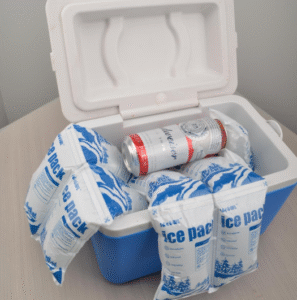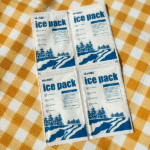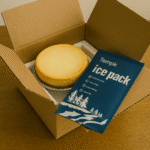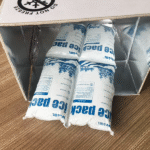Wenn Sie gefrorene Waren versenden, Trockeneisbeutel helfen Ihnen, konform zu bleiben, sauber, und durchweg kalt. Sie enthalten Pellets oder Blöcke und lassen gleichzeitig CO₂ entweichen, So bleibt Ihr Produkt gefroren und die Handhabungsgeräte bleiben sicher. In dieser Anleitung erfahren Sie, wie Sie die Größe bestimmen, Pack, Etikett (UN1845), und wählen Sie Alternativen für 24–72-Stunden-Fahrspuren in 2025.
-
Wann sollten Trockeneisbeutel für gefrorene Bahnen verwendet werden? und wie sie sich von Gel- und PCM-Beuteln unterscheiden
-
Wie viele Trockeneisbeutel Sie wirklich benötigen für 24–72 Stunden ohne Überzahlung
-
So beschriften und entlüften Sie richtig unter UN1845 und IATA PI 954 In 2025
-
Wann sollte man stattdessen Gel oder PCM wählen? um gefährliche Stufen auf gekühlten Strecken zu vermeiden
-
Trends für 2025 die sich auf Materialien auswirken, Akzeptanz -Checklisten, und Nachhaltigkeit
Was sind Trockeneisbeutel und wann sollten Sie sie verwenden??
Kurze Antwort: Trockeneisbeutel sind belüftet, Reißfeste Beutel oder Hüllen, die festes CO₂ in einem isolierten Versandbehälter halten, sodass Gas entweichen kann, während Ihre Waren gefroren bleiben. Verwenden Sie sie, wenn Sie eine Kontrolle über mehrere Tage lang gefrorenes Futter benötigen (≤ –18 ° C.), Sicherer Handling, und ordentlichere Verpackung als lose Pellets.
In der Praxis: Der Beutel trennt das Kältemittel vom Produkt, reduziert Unordnung, und verbessert die Platzierung rund um die Nutzlast. Einige Teams verwenden auch isolierte „Thermobeutel“ mit Gel oder Trockeneis, um die Haltezeit in Versandtaschen und Tragetaschen zu verlängern. Vergewissern Sie sich immer, dass der „Beutel“, den Sie kaufen, für den Inhalt bestimmt ist Trockeneis und nicht die Produkt.
Trockeneisbeutel vs. Gelpacks vs. PCM-Beutel
Fazit: Trockeneisbeutel sorgen für ultrakalte Kopffreiheit; Gel und PCM halten schmaler, wärmere Bereiche mit einfacherer Buchung. Trockeneis liegt bei etwa −78,5 °C, Während typisches Gel bei etwa 0–5 °C liegt, können PCM-Steine je nach Bedarf eine Temperatur von −20 °C oder +5 °C erreichen. Verwenden Sie Trockeneisbeutel für tiefgefrorene Fahrspuren und heiße Strecken.
| Kältemitteloption | Typische Reichweite | Am besten für | Was es für Sie bedeutet |
|---|---|---|---|
| Trockeneisbeutel | ~ −78,5°C | 24–96 h gefroren | Erfordert Entlüftung und UN1845/Klasse 9 auf dem Luftweg; höchste Kühlleistung. |
| PCM-Beutel (Z.B., –20 ° C oder +5 ° C.) | −25 °C bis +7 °C | 12–36 Stunden gefroren oder gekühlt | Strengere Kontrolle ohne GD-Papierkram bei vielen Diensten. |
| Gelpackungen | 0–5 ° C | Über Nacht gekühlt | Einfach, wiederverwendbar, aber nicht für lange gefrorene Laderäume. |
Praktische Tipps, wenn Sie mit Trockeneisbeuteln noch nicht vertraut sind
-
Niemals CO₂ einschließen. Verwenden Sie poröse oder Belüftungsbeutel; Den Beutel niemals heißversiegeln.
-
Voraussetzung. Frieren Sie das Produkt hart ein und kühlen Sie den Versandbehälter vor, um eine frühzeitige Beladung zu vermeiden.
-
Masse verteilen. Mehrere kleinere Taschen rund um die Nutzlast schlagen einen großen Stein.
Schnappschuss aus der realen Welt: Eine Bäckerei, die Eistorten verschickt, wechselte von losen Pellets zu Trockeneisbeuteln und schnitt die Reinigung ab, während die Haltezeit durch die Kontrolle von Gesamtgewichten und Entlüftungswegen konstant gehalten wurde.
Wie viele Trockeneisbeutel benötigen Sie für 24–72 Stunden??
Schnelle Regel: Beginnen Sie mit ~2,5–5 kg pro 24 H für einen 10–15-Liter-Versender bei warmem Wetter, dann per Spurtest abstimmen. Auf 2–4 Trockeneisbeutel aufteilen, um die Kaltoberfläche und Stabilität zu vergrößern.
Warum funktioniert es: Trockeneis nimmt beim Sublimieren eine große Menge Wärme auf; Planung nach Fläche und Umgebung, nicht nur Liter, liefert zuverlässigere Ergebnisse.
| Dauer | Leicht (≤22°C) | Warm (23–30°C) | Heiß (≥31°C) | Was zu tun |
|---|---|---|---|---|
| 12 H | 1–2 kg | 2–3 kg | 3–4 kg | 1–2 Trockeneisbeutel pro 12 L Versender. |
| 24 H | 2.5–4 kg | 4–6 kg | 6–7 kg | Fügen Sie Seitentaschen hinzu, um die Oberfläche zu vergrößern. |
| 48 H | 5–7 kg | 7–10 kg | 10–12 kg | Verbessern Sie die Isolierung oder die Anzahl der Beutel. |
| 72 H | 7–9 kg | 10–13 kg | 13–16 kg | Validierung bei Spitzenbedingungen im Sommer. |
Platzierung und Belüftung für Trockeneisbeutel
Platzieren Sie Trockeneisbeutel am Boden und an den Seiten, Zentrieren Sie die Nutzlast, Dann mit einem weiteren Beutel bedecken. Halten Sie die Auskleidungen offen und die Außenbox entlüftungsfähig; Vermeiden Sie vollständig versiegelte Nähte oder luftdichte Kühlboxen. Markieren Sie die Netto-Trockeneismasse in Kilogramm.
Praktisch, Benutzerfreundliche Tipps
-
Heiße Spur? Fügen Sie neben dem Produkt ein dünnes PCM mit einer Temperatur von −20 °C hinzu; Schieben Sie die Trockeneisbeutel nach außen.
-
Gemischte SKUs? Mit einer starren Innenseite trennen, um Quetschungen und Kältestellen zu vermeiden.
-
Notizen erhalten. Fügen Sie einen Zettel mit dem Vermerk „Mit Trockeneis verpackt“ und den Netto-Kilogrammen bei.
Kurzfall: Zwei 2.5 Trockeneisbeutel mit einem Gewicht von kg und ein dünnes PCM mit einer Temperatur von –20 °C hielten eine Eislieferung 48 Stunden lang unter –18 °C, trotz einer zweistündigen Verzögerung im Depot.
Welche 2025 Für Trockeneisbeutel gelten Regeln, und wie besteht man die Abnahme?
Grundregel für Luft: Markieren "Trockeneis" oder "Kohlendioxid", solide,”UN1845 und die Netto -Trockeneisgewicht (kg) auf der gleichen Seite wie die Klasse 9 Etikett. Verpackungen und Beutel müssen Entlüftung. Bei Verwendung mit Nicht-DG-Waren ist häufig keine Versendererklärung erforderlich, Es gelten jedoch weiterhin Akzeptanzchecklisten.
Passagier vs. Ladung: Das Gepäck ist normalerweise mit Trockeneis begrenzt 2.5 kg pro Passagier Mit Fluggesellschaftszulassung und belüfteter Verpackung; Ladung folgt PI 954 und Operatorvariationen. Behandeln Sie die Personenbeförderung als eine andere Regelung.
Schnelle Compliance-Checkliste für Trockeneisbeutel (Kopieren/Einfügen in SOP)
-
Verwenden Sie speziell angefertigte Trockeneisbeutel; nicht CO₂ in Kunststoff einschließen.
-
Halten Sie die Liner offen; stellen Sie sicher, dass äußere ist entlüftungsfähig.
-
Markieren UN1845, Eigenname, Und Netz kg; Klasse anwenden 9 Etikett.
-
Buchen Sie einen Service, der Trockeneis akzeptiert; Fügen Sie nach Bedarf AWB-Details hinzu.
Trockeneisbeutel oder Alternativen: was zu deiner Spur passt?
Wählen Sie Trockeneisbeutel wenn Sie das Produkt durchgehend gefroren halten müssen, Transit überschreitet 36 Std., oder Umgebungstemperaturen über 30 °C. Wählen Sie PCM-Beutel für enge Bänder (–20 ° C oder +5 ° C.) ohne DG-Papierkram. Wählen Sie Gel für gekühlte Lieferungen am Tag oder über Nacht.
Zweiminütige Spurkontrolle (Selbsteinschätzung)
-
Muss die Nutzlast festgefroren bleiben??
-
Wird der Transit überschreiten 36 Stunden von Tür zu Tür?
-
Wird die Umgebungstemperatur unterwegs 30 °C überschreiten??
-
Akzeptiert Ihr Mobilfunkanbieter UN1845 für Ihren Dienst??
Wenn Sie es überprüft haben 3+ Boxen, Design rund um Trockeneisbeutel; andernfalls versuchen Sie es mit einem PCM-First-Packout.
2025 Entwicklungen und Trends für Trockeneisbeutel
Was ist neu: Die Bediener haben die Arbeitshilfen für die Abnahme aktualisiert, um den Schwerpunkt auf die Entlüftung zu legen, Etikettengröße, und Netto-kg-Sichtbarkeit. Verpackungsanbieter expandierten „Trockeneisbeutel“ auf Papierbasis und isolierte Thermotaschen; kompostierbare Gele reifen als Kurzstreckenalternativen heran, wenn das Trockeneis begrenzt ist.
Letztes auf einen Blick
-
Klare Anleitung „Kein versiegeltes Plastik“. in Akzeptanzchecklisten reduziert das Ablehnungsrisiko.
-
Optionen für Öko-Beutel Reduzieren Sie den Abfall und verbessern Sie gleichzeitig die Feuchtigkeitskontrolle in den Kartons.
-
Verlader mit Doppelstrategie gewinnen: Trockeneisbeutel für heiße Autobahnstrecken, Kurz: PCM-Beutel, geregelte Fahrspuren.
Market insight: Das Wachstum bei gefrorenen E-Lebensmitteln und Biologika treibt gemischte Kältemittelstrategien und eine bessere Isolierung voran, mit validierter Packout-Geometrie, die nachweislich genauso wichtig ist wie die Gesamtmenge an Kilogramm.
Häufig gestellte Fragen zu Trockeneisbeuteln
Q1: Sind Trockeneisbeutel dasselbe wie vakuumversiegelte Eisbeutel??
NEIN. Trockeneisbeutel müssen Gas entlüften um sicher und konform zu sein; Vakuumieren mit CO₂ ist unsicher.
Q2: Kann ich Trockeneisbeutel in einen Polyliner stecken??
Ja – behalten Sie den Liner offen So kann Co₂ entkommen; Auch die Außenverpackung muss entlüftet sein.
Q3: Wie viel Trockeneis benötige ich dafür? 48 Std.?
Planen ~5–9 kg für eine kleine Kühlbox bei warmem Wetter, auf mehrere Beutel aufgeteilt. Validieren Sie auf Ihrer Fahrspur.
Q4: Welche Etiketten gehören auf eine Schachtel mit Trockeneisbeuteln??
Anwenden UN1845, der richtige Name, Netto-Kilogramm, und a Klasse 9 Etikett auf derselben Seite.
Q5: Funktionieren Trockeneisbeutel für Lebensmittellieferungen??
Ja. Sie verhindern den direkten Kontakt mit Pellets und reduzieren die Verschmutzung, Ideal für Trockeneisbeutel für den Versand von Lebensmitteln Szenarien. Belüftete Verpackung und Handschuhe verwenden.
Zusammenfassung und Empfehlungen für Trockeneisbeutel
Erinnern: Trockeneisbeutel machen den Tiefkühltransport sauberer und sicherer, indem sie Pellets enthalten und gleichzeitig die Entlüftung von CO₂ ermöglichen. Bestehen Sie die Abnahme durch Markieren UN1845 mit Netto-Kilogramm und Verwendung von entlüftungsfähigen Außenmaterialien. Größe nach Route, Ambient, und Oberfläche statt Liter allein.
Nächste Schritte: Kartieren Sie Ihre Fahrspurzeit und Umgebungstemperatur, fangen Sie an 2.5–5 kg pro 24 H, Auf mehrere Trockeneisbeutel aufgeteilt, und führen Sie einen Versuch durch. Standardisieren Sie Ihre SOP und Etiketten, Passen Sie dann basierend auf den Daten ±1 kg an.
Über Tempk
Wir helfen Essen, Pharma, und Biotech-Teams wählen validierte Versender, Größe Trockeneisbeutel oder PCMs genau, und übersetzen 2025 Akzeptanzregeln in einfache Checklisten umwandeln. Unser Vorteil sind praktische Taschenrechner, echte Spurprüfung, und schnell zu verpackende SOPs, die Reklamationen und Kosten reduzieren.
CTA: Teilen Sie Ihre Kartongröße mit, Fahrbahn, und Zieltemperaturen – erhalten Sie eine kostenlose, Heute gibt es ein spurspezifisches Verpackungs- und Etikettenset.
























